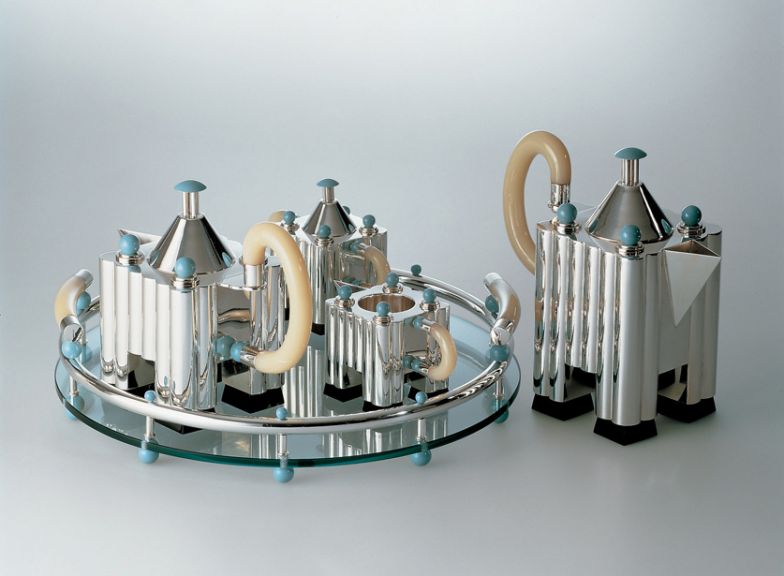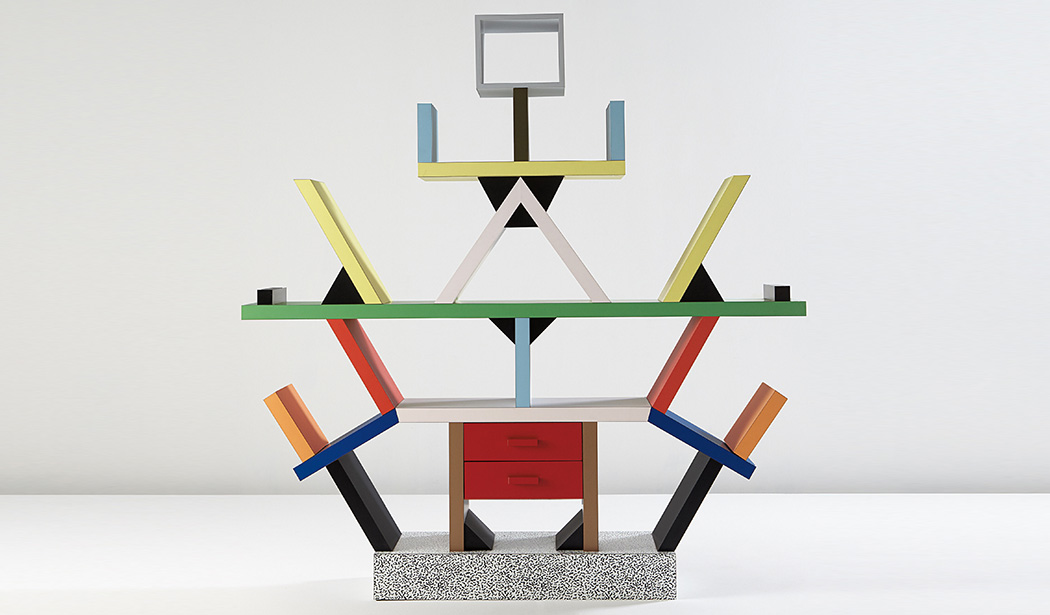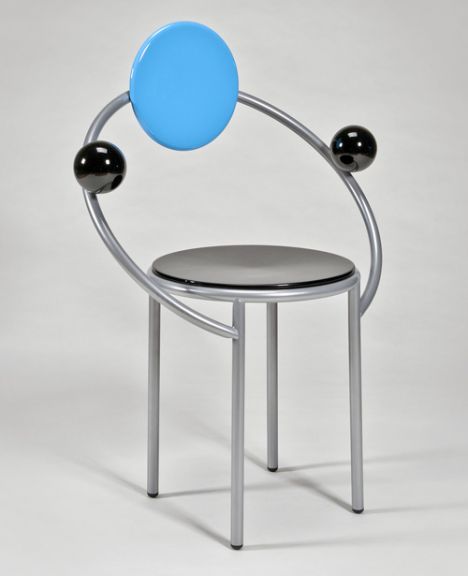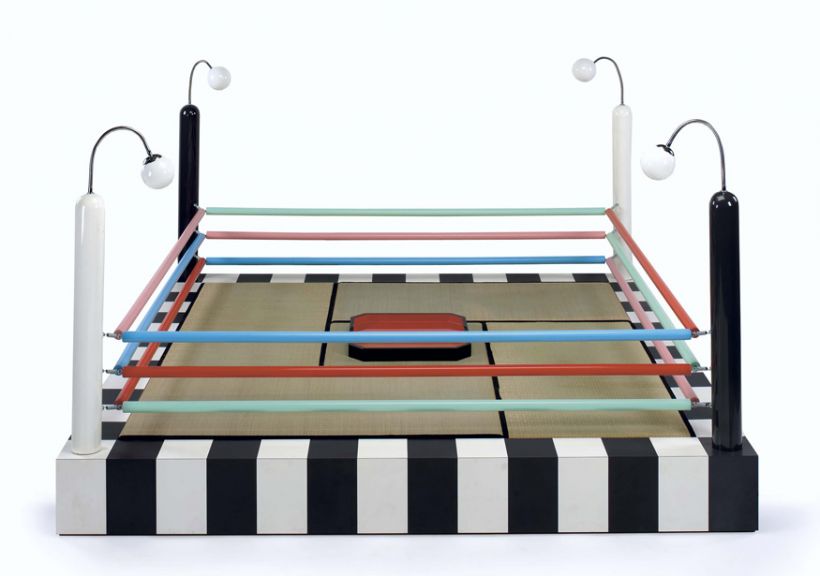When “Postmodernism: Style and Subversion, 1975–1990” opened at London’s Victoria and Albert Museum in September of 2011, David Bowie was among the privileged few given a private tour. His response was reportedly to acquire a huge collection of postmodern objects. Although it’s unlikely that many visitors responded quite so enthusiastically, the exhibition did call attention to a style that had been largely ignored for decades. Since then, interest has been building, with sources in the design world predicting a comeback for the style that was marked by equal parts hype and controversy during its ’80s heyday. Last July’s proclamation by the online design-industry journal Dezeen that, “Love it or hate it, postmodernism is back,” may have seemed a bit premature, but as the media took notice, headlines proliferated hailing the movement’s return.
Now, all signs suggest those predictions were right on target. The movement’s iconic objects—such as Ettore Sottsass’s Carlton bookcase and Michael Graves’s Whistling Bird teakettle—make regular appearances in the media as well as at 20th-century design sales. A Carlton brought $17,500 on a $6,000-to-$8,000 estimate at Phillips in New York last December, while Sottsass’s Murmansk silver cup sold for £8,750 ($13,300) at Sotheby’s London in November. According to Keith Johnson, who has been a distributor of Memphis design since 1981 and currently shows the group’s designers at his Brooklyn gallery, Urban Architecture, sales have tripled in the past several years.
From a timing perspective, the revival is right on cue: Styles generally resurface on a three-decade cycle. But postmodernism is more than just another design approach. Evolving from a 19th-century philosophy that influenced art and literature, postmodernism surfaced in architecture and design with Robert Venturi’s 1966 Complexity and Contradiction in Architecture and was defined as gospel with the 1977 publication of Charles Jencks’s Language of Postmodern Architecture, a manifesto protesting the constraints and sterility of then-dominant International Style modernism. On the popular side, however, postmodernism can be summed up in a single word: Memphis. Although architectural incarnations such as Graves’s Portland Building in Oregon and Philip Johnson’s Chippendale-topped AT&T Building (now the Sony Tower) in New York generated heated discussion, it was the spectacle of Memphis objects that catapulted postmodern design into the public eye.
Organized in Milan by Ettore Sottsass and a cohort of young architects and designers distressed by the dearth of originality in the contemporary design of the postwar years, Memphis sought to offer more avant-garde options. The result was a no-holds-barred collection of furniture, lighting, and accessories unlike anything the market had ever seen or imagined. Its debut at the 1981 Salone del Mobile in Milan generated media coverage that cast design in a limelight previously reserved for film and fashion. In a market dominated by sleek Scandinavian and pristine Bauhaus objects, Memphis was a refreshingly irreverent change of pace.
While the name is used by some as a loose synonym for postmodernism, and sometimes refers to the firm that purchased the name and continues to produce the designs, the original Memphis collective lasted for just eight years, joining Italian members like Andrea Branzi, Michele de Lucchi, and Alessandro Mendini with an international roster including Graves, Hans Hollein, Shiro Kuramata, and Peter Shire. Sottsass and his colleagues sought to approach design without the restrictions of functionalism or any predetermined rules. Notwithstanding the serious ideas behind the objects, the Memphis designers’ transgressive use of quotidian materials, clashing color and pattern, and bizarrely functionless forms were an in-your-face challenge to accepted concepts of good design—and good taste. The Carlton bookcase epitomized the collective’s use of colorful laminates, Pop graphics, and unconventional form. Design arbiter Bertrand Pellegrin described the design as “a shotgun wedding between Bauhaus and Fisher-Price” in the San Francisco Chronicle in 2012.
Most of the Memphis pieces were made in limited numbers. Priced from $2,000 to $10,000, they were too costly even for interested buyers. (Even costlier, Graves’s Plaza dressing table was priced at $33,000 when it debuted in 1981 at New York’s Furniture of the 20th Century showroom, the first U.S. distributor of Memphis.) But the objects were, in any case, intended to make a point, not a profit.
Accordingly, there were few who didn’t have an opinion about Memphis, much of it negative. Critics had a field day, but others admired its freewheeling attitude, recognizing the substance beneath the flippant façade. “I believe the postmodern style is historically significant,” says Miami collector Al Eiber, an early fan of the movement. “It’s a complete reversal from less is more.” Fashion leaders were intrigued; couturier Karl Lagerfeld famously furnished his Monte Carlo apartment entirely in Memphis. For most people, however, the problem was figuring out how individual pieces—specifically seating and tables—fit into a unified interior. “Furniture requires commitment,” says Carina Villinger, head of 20th- and 21st-century design at Christie’s New York. “You can always use another vase, but you only need one sofa.” Alex Heminway, design director of Phillips New York, puts it more pointedly: “Postmodern design has never been easy to live with. Most clients, at the end of a long day and behind closed doors, want their chairs to converse with them rather than shout.”
Although the most promoted, Memphis was not the only part of the story, as many members of the collective also designed for manufacturers that introduced pieces as part of their lines. Italian powerhouses Cassina and Poltronova offered postmodern furniture, and Robert Venturi designed a collection of chairs for Knoll that riffed on classic period styles.
More visibly and accessibly, postmodern design found expression in tableware and accessories. The design of attention-getting postmodern buildings had made architecture a newsworthy topic and turned its leading practitioners into celebrities, fostering the emergence of the starchitect. Savvy manufacturers, most notably Alessi, Cleto Munari, and Swid Powell, commissioned marquee names to design products. Alessi’s Coffee and Tea Piazza project of 1983, introducing 11 sterling silver services, by an international roster of architects, priced in the five-figure range, was a succès d’estime, bringing cachet but few sales. But Graves’s bird teakettle, also designed for Alessi, in 1985, was reported in the New York Times in 1988 to have sold some 100,000 units at $115 each. Graves’s own knockoff of the object was also heavily used in advertising for Target as the retailer rebranded its image from low-end outlet store to a source of good design at popular prices.
The postmodernist love affair, such as it was, was relatively brief, and the style was moribund by the end of the 1980s, the victim of overexposure and kitschy knockoffs. Sottsass left Memphis in 1985, and the collective disbanded in 1988. The famed Lagerfeld collection went on the block at Sotheby’s in 1991. Despite its relatively short life, however, the influence of Memphis and other postmodern design ventures was enormous—and enduring. In opening the door to unfettered expression, it permanently expanded the possibilities for original design. “It opened the floodgates and once again allowed designers to use historical forms as well as exuberant ornament, pattern, color, and materials,” says curator R. Craig Miller, formerly of the Metropolitan Museum of Art and the Indianapolis Museum of Art. “More importantly, it established a new conceptual basis for design where objects were no longer thought of primarily as functional products but also as works of art.”
Such assessments bode well for postmodern design as it undergoes an art historical reassessment. On the secondary market, however, it remains a tricky category. It’s comparable neither to the iconoclastic works that straddle the line between art and design and bring six-figure prices just a few years out of the studio, nor to the handcrafted treasures of past eras like Art Deco. Somewhat anachronistic, the pieces are too new to be antique and too quirky and heavily marketed to be revered as art. But the auction houses are finding interest in the top names: Sottsass, Graves, De Lucchi, Mendini, and Kuramata.
“Collectors will pay important prices for small-edition or iconic objects,” says Florent Jeanniard, 20th-century design director at Sotheby’s Paris, who points out that Kuramata’s 1989 Placebo table fetched £21,250 ($32,782), more than double its low estimate, at Sotheby’s London last November. The designer’s celebrated Miss Blanche chair of the same years brought a world-record £269,000 ($413,829) in the same sale. And a rare sighting of Masanori Umeda’s Tarawaya boxing ring sofa brought $34,800 at Christie’s New York in 2005.
Other postmodern designs, most often from Memphis affiliated names, are gaining market momentum: A Sottsass Totem ceramic piece sold for €62,500 ($77,375) at Dorotheum in Vienna in 2014, and a De Lucchi Sebastopol table brought $10,625 at Bonhams Los Angeles last October. Glass and ceramic objects sell for more modest prices, in the low five figures. They are considered to be a good buy, as are Robert Venturi’s witty chairs, which can be found on the site for about $7,500 each.
All this activity cannot be credited to just one museum program. The 2011 V&A show’s most immediate impact could be seen in growing interest in the dormant style among curators. Subsequent exhibitions have highlighted the Memphis group or earlier avant-garde designers, and recent years have seen postmodernism-related shows as far afield as South Africa, which showcased “Totemism: Memphis Meets Africa” at Design Indaba Expo in Cape Town in 2013; Turkey, where “Global Tools, 1973–1975” appeared at Salt Istanbul in 2014; and Helsinki, where the Design Museum Finland mounted “Postmodernism, 1980–1995” last year. In the U.S., “Memphis-Milano, 1980s Italian Design,” was presented at the Dixon Gallery and Gardens in Memphis in 2014.
At the same time, galleries began cultivating a new collecting community. “The collector base has broadened over the past few years,” says Chicago and New York auctioneer Richard Wright. “The ’80s aesthetic is coming back for serious reconsideration.” Buyers of postmodern objects tend to be connoisseurs rather than investors. Interior designers, with rare exceptions like color-loving Kelly Wearstler, are generally resistant.
“The objects and furniture are very domineering,” says Friedman Benda principal Marc Benda, who mounted a show on Sottsass in 2014 and another last year. “Design aficionados are more adventurous in integrating pieces into their environments, and art collectors tend to hunt down the icons of the period.” Millennials, however, are taking notice. Johnson of Urban Architecture reports he has clients who weren’t born when the style surfaced, but “relate to it what they see in old MTV videos or reruns of Miami Vice.” Koenig & Clinton owner Margaret Clinton says that many visitors to the New York gallery’s Memphis exhibition in late 2014 and early 2015 had never seen the original objects in person, “or certainly not that many gathered in a single room.”
One challenge to the collectibility of the movement’s objects is that many of the pieces are still in production, keeping prices in check. Interestingly, a Mendini Proust chair, still being sold for Cassina and retailing for around $13,000, sold for £46,850 ($64,300) at Bonhams Knightsbridge just after the V&A postmodernism show opened; a vintage example was offered recently on 1st Dibs for $25,000. A new Carlton is listed for €12,822 ($14,255) in the Memphis-Milano online store. As longtime collector Dennis Zarone, whose collection was the basis for the Dixon Gallery and Garden exhibition, notes, “The prices aren’t much different from those in the original catalogs.” There are still bargains to be had, but that’s likely to change.
As with any unusual design, buyers often rely on a knowledgeable dealer. “You need knowledge, passion, and patience to find the right works and to be able to represent properly what it is you are selling,” says Benda. It seems reasonable to predict that postmodern designs, like those of once-derided Art Deco, will become the valued antiques of the next generation. In a very real sense, we have postmodernism to thank for the diversity of today’s style choices and for the idea that design doesn’t always have to be taken seriously. In that sense, the new wave of postmodernism isn’t really a revival; it’s just been waiting in the wings for a return to center stage.



